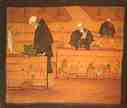Some experiences from an outside teacher at the
Erasmus Course:
Why this is important:
Students in the humanities should have access to and be trained in the latest technology. Think about the hard job market you are going to enter. A fine degree as MA or Ph-D alone is not enough. Do combine your training with skills in the technology of tomorrow (which already exists today): multimedia, Internet, especially WWW, etc. If you will be a school-teacher, your students will already grow up in such an environment. You have then of course to be a bit more advanced then they are. The same holds true if you will have a job within the media-world (newspapers, radio, tv, etc.) or in a library, an archive, a museum. Nothing goes longer without a multimedia-approach.
If you should encouter difficulties at your own university: go to your dean, your university president or rector and tell them about existing modern standards. What is possible at
Tampere University, is possible elsewhere as well.
To be in the Web means to be connected to the WORLD.
|
![]() The Finnish National Gallery, Helsinki
The Finnish National Gallery, Helsinki![]() The Famous WEB-Museum, Paris (Swedish mirror)
The Famous WEB-Museum, Paris (Swedish mirror)![]() and of course the even more famous picture In the Garden of Death by Hugo Simberg (1873-1917) in Tampere Cathedral (open daily 11-15 hours) (have even a look at the water color version, with the connection the H. C. Andersen)
and of course the even more famous picture In the Garden of Death by Hugo Simberg (1873-1917) in Tampere Cathedral (open daily 11-15 hours) (have even a look at the water color version, with the connection the H. C. Andersen)
